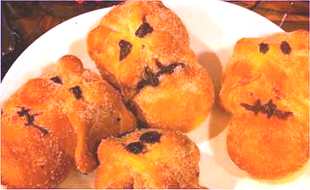|
The Feel-Good Guide to Sports, Travel, Shopping & Entertainment
|
||
| Main | Sports Events | Holidays & Observances | Pop Culture | Shopping | Travel |
|
MAIN
With some similarities to an American Halloween, Dia de los Muertos is a festive celebration which survives from ancient Mexico. It was only when the Spaniards arrived in the 16th century that the festival was paired with the Catholic All Souls Day and All Saints Day, celebrated on November 1 and November 2. As they still say in Mexico, "Nobody truly dies unless they are forgotten". The day is still a very special one, helping to keep family memories alive. Children are remembered on the Day of the Innocents ("Día de los Inocentes") on November 1, followed by other loved ones who are counted among the dearly departed on November 2, the Day of the Dead.
In ancient Mexico, rituals celebrating the lives of dead ancestors had been performed by Mesoamerican civilizations for at least 3,000 years. Festivities were presided over by the goddess Mictecacihuatl, known as the "Lady of the Dead". It was common practice to use skulls as trophies and display them during rituals to symbolize death and rebirth. The festival began in early August and was celebrated for the entire month.
One particular tradition that lives on today is a recipe for sugar skulls, which are brightly decorated and served up by Day of the Dead devotees and party hosts with ghoulish glee. Local bakeries also feature special breads and cakes in playful shapes of skulls to serve as holiday treats. Most recently, the Day of the Dead was poignantly introduced worldwide to movie audiences with the Disney'/Pixar animated film Coco. The animated tale tells the story of a young Mexican musician who enters the Land of the Dead to find his great-great-grandfather, a legendary singer, and to unlock the real story behind his family's history. The bittersweet celebration includes traditions still devoutly observed today during Day of the Dead, such as building home altars to honor the dead. Gavesites of relatives in local cemeteries are also ritually cleaned and decorated for the occasion.
Many Mexicans also still observe the tradition of offerings of the customary Pan de Muerto, a sweet cake. Deceased children (called los angelitos, or little angels) are also honored with new toys, while adults are honored with their favorite food and drink to help vibrantly recall the special things that gave the deceased joy while they were alive.
Just up ahead, check out more traditions old and new online - as Dia de los Muertos comes alive and kicking in outstanding photo galleries, folk art exhibits, e-cards, video clips, history, craft ideas, recipes and trivia...
Mexican Day of the Dead - Dia de los Muertos - Check out Day of the Dead central, including an extensive cache of articles and photo essays on the altar to the dead, candlelight vigils, gravesite ceremonies, folk art, activities and traditions. MEXonline: Day of the Dead Holiday - Here's a good overview with feature stories chronicling the history and traditions of Dia de los Muertos, where to find the best locations for authentic ceremonies, a special report from Oaxaca, and related resources. |
 This year, Day of the Dead observances are celebrated beginning on the evening of Thursday, October 31, and end on Saturday, November 2, 2024.
This year, Day of the Dead observances are celebrated beginning on the evening of Thursday, October 31, and end on Saturday, November 2, 2024. 
